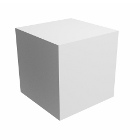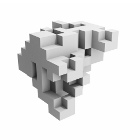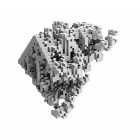





|
|
Breed Computers are powerful machines to harness artificial evolution to create visual images. To achieve this we need to design genetic algorithms and evolutionary programs. Evolutionary programs allow artefacts to be "bred", rather than designing them by hand. Through a process of mutation and selection, each new generation is increasingly well adapted to the desired "fitness" criteria. Breed is an example of such software that uses Artificial Evolution to generate detailed sculptures. The algorithm that we designed is based on two different processes: cell-division and genetic evolution.
The underlying principle of the Breed morphogenesis is division of cells. One initial cell, a cube,
engenders throughout successive stages of cell division a complex,
multi-cellular "body". Morphogenetic rules determine how the division of a cell occurs, dependent on
its situation between the cells surrounding it. Every potential
situation has a separate rule, so a cell surrounded on all sides by other cells may divide
differently from a cell that only has a neighbour on the left and underneath, or a cell with nothing
at all in the vicinity, etc. Each rule is coded in a gene, and the complete set of rules forms the
genotype of the growth. The appearance of such a virtual Breed object may take many forms. The majority of these are comprised of many parts floating separately from each other in space. This is no problem while it remains a computer model on the screen where gravity does not count, but turned into real material, subject to gravity, such an incoherent structure would collapse. To automate the search for constructable results, it is necessary to establish objective and measurable preconditions for constructability. One crucial condition is that the phenotype should be completely coherent, i.e. consisting of a single part. The computer can compare two models with each other by counting the number of separate parts the model contains. The model with fewer parts satisfies the criterion of "coherence" more, or rather is "fitter" than the model with the higher number of parts. We are now able to implement a computerised process of trial and error that incrementally evolves in the direction of potential solutions. The simplest method (two-membered evolution strategy) is already effective: take a randomly composed genotype as base, generate the phenotype and test it for fitness; mutate the base genotype, generate the phenotype and test it for fitness; compare both results with each other, and take the result with the highest fitness as the new base. Repeat the mutations until the result satisfies the stated requirements. An initial series of six sculptures was executed manually in plywood. The tracing, sawing and gluing was a time consuming technique and in any case, we wanted an industrial procedure. It was not possible to produce such complex forms via computer controlled Rapid Manufacturing techniques until the end of the nineties. Only with the arrival of the SLS (Selected Laser Sintering) technology did it become possible to computerise the whole line from design to execution. A second series of nine samples was realised with this technique in DuraForm nylon. In 2007, a series of six sculptures is produced with the Printing Metal technique. These objects are made out of stainless steel, infiltrated with bronze. The results became smaller and more detailed so that the separate cells of the objects began to be absorbed into the total form.
review Paul Prudence website Data is Nature
|